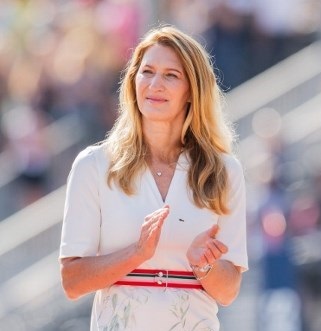LONDON: German tennis legend and one of the greatest women players in the world Steffi Graf turned 51 today.
During her 17-year career, the former champion collected 22 Grand Slam singles titles and spent a record 377 weeks as world number one.
At 19, Graf won the Australian Open, French Open, Wimbledon, US Open and Olympics in 1988.
The Golden Slam. American Serena Williams now owns a modern-era record 23 Grand Slam singles titles and Roger Federer is, for many, the greatest player, man or woman, to wield a tennis racket. Neither have managed a year quite like that.
A frizzy-haired girl from Mannheim had already begun turning heads in 1982 — the year Graf debuted on the WTA Tour aged 13.
By 1985 she was in the world’s top 10 and in 1987 beat Navratilova to win the French Open. While so many teen upstarts at the time suffered burnout, Graf’s all-round game, perfect tennis physique and mental stability ensured she would withstand the rigours of the sport.
Her preference for a classic, underspin backhand was a nod to former greats, but a whiplash forehand and heavy serving, were tailor-made for the emerging power game. Graf began 1988 by winning the Australian Open without the loss of a set, beating Evert in the final.
In the French Open final she thrashed unfortunate Russian teenager Natasha Zvereva 6-0, 6-0 in 32 minutes — the shortest Grand Slam final.
Weeks later at Wimbledon “Fraulein Forehand”, the moniker bestowed on her by tennis writer Bud Collins, dethroned Wimbledon queen Navratilova, reversing her 1987 final loss, before clinching the women’s doubles title to boot. “This is the end of a chapter, passing the torch if you want to call it that,” Navratilova remarked at the time.
At the US Open, Graf scythed through to the final where she beat elegant Argentine Gabriela Sabatini to become only the fifth player to complete the fabled ‘calendar year’ Grand Slam and the only player to do it on hard, clay and grass.
Gordon Jorgensen, then president of the USTA, gave Graf a bracelet with four diamonds to mark her feat and a few weeks later in Seoul it was gold after beating Sabatini again in the Olympic singles final.
With Evert retiring and Navratilova waning, Graf was totally dominant and would have won back-to-back Grand Slams had it not been for gritty Spaniard Arantxa Sanchez Vicario who beat her in the 1989 French Open final.
Graf needed a natural rivalry and in the emergence of Yugoslav teenager Monica Seles she found one, and some.
Seles, only 16, snapped Graf’s 66-match winning streak by beating her in her own backyard at the 1990 German Open, and a few weeks later beat her again in the French Open final.











